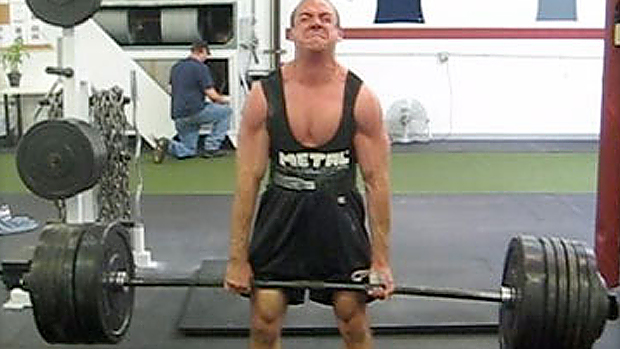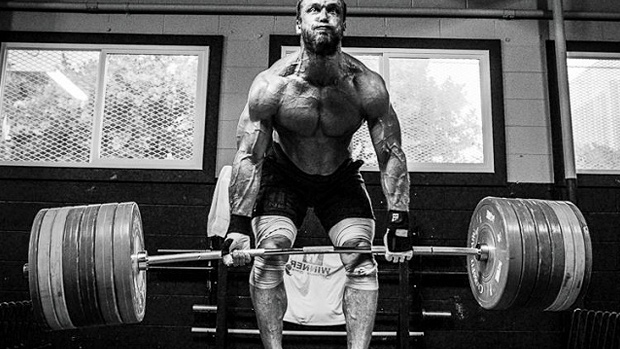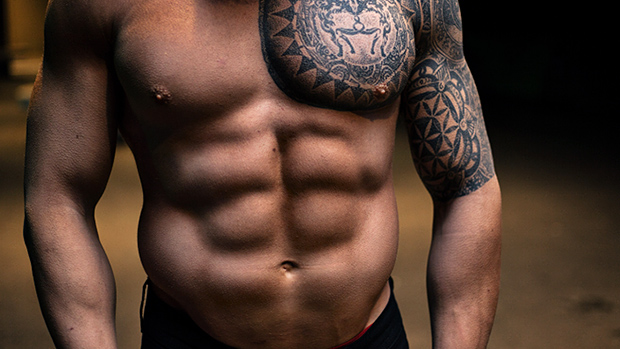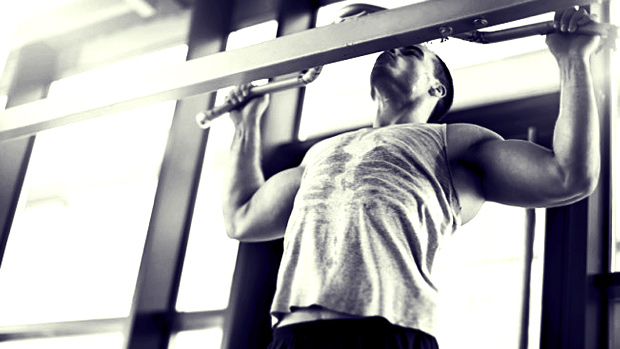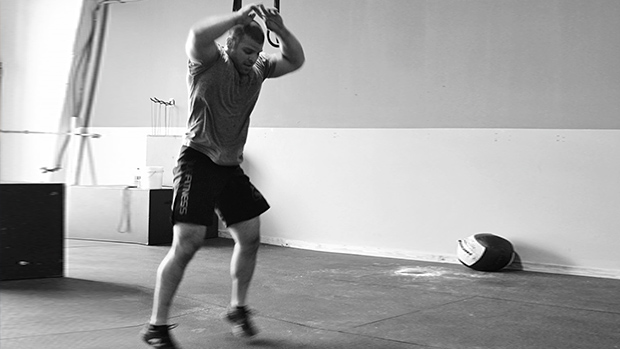"... Tao is often referred to as 'the nameless', because neither it nor its principles can ever be adequately expressed in words."
Aw, what the hell, we'll give it a shot.
No questions, no time limit, and no stone unturned. Training? Nutrition? A little piss and vinegar? It's all here.
The following is what happens when you get on the phone with a top-level strength and conditioning coach and hit "record."
—NG
Eric Cressey Speaks
Why do guys suck at writing their own training programs? Most hold down jobs or are students and just don't have the time to do research. Sometimes a specialist knows better. Look at it this way: if I want a contract drawn up, I go to a lawyer. If I want my taxes done, I go to an accountant. I don't have the time to learn how to do either. You want a program? Go to T NATION or hire an expert.
Yeah, there are some people who can gain the experience and perspective and can write their own programs. There's something to be said for getting 80 percent of it right, as long as you're putting in the effort. Working your ass off on a mediocre program is better than sitting on your ass.
The question I hate the most is, "What's your training philosophy?"
Damn it, I knew you were going to ask that ! Well, what are you, a 55-year old weekend warrior or a 16-year old pitcher with elbow pain? It's a hard answer to give. My philosophy is trying to teach people how to turn off the stupid and recognize the answer is usually "grey" and not just "black" or "white."
I always go back to a four-day, upper/lower split and train Monday, Tuesday, Thursday, and Saturday. I also do a day of sprint work and a day of metabolic conditioning stuff to make sure my heart doesn't explode at age 28. Six days per week of activity is perfect.
I'll rotate my heavy movements and do different squat, bench, and chin-up variations on a week-by-week basis. But I'll keep the assistance stuff the same across the board for a month or so before changing it up. You still need some indicators on whether or not you're progressing.
A sample week? Sure.
All lifts are preceded by foam rolling and mobility work, and I'm generally working some corrective stuff in between sets like ankle mobility work between sets of deadlifts. As you can see, there's some Westside influence. I'm squatting more now because a) I like it, b) I'm not as good a squatter as I am a deadlifter, and c) I just did enough deadlifting in a month for every guy on T NATION.
Monday: Lower Body
A. Safety Squat Bar Box Squats vs. Chains, speed work
B. Giant Cambered Bar Forward Lunges
C1. Decline Glute-Ham Raises
C2. Cable Woodchops
D. Side-Lying External Rotations (rotator cuff)
I get Graston® or ART® done later in the day on Mondays. Usually on my upper body.
Tuesday: Upper Body
A. Heavier bench variation, sets of 1 to 4 (This week it was close grip bench with chains.)
B1. Neutral Grip Pull-ups
B2. Alternating DB Floor Bench Press
C1. TRX Ys
C2. Thick Handle Hammer Curls
D. Short Medley: Overhead Sledgehammer Swings to Tire paired w/Farmer's Walks
Wednesday: Med Ball Work and Sprinting
Thursday: Lower Body
A. Heavier squat variation, sets of 1 to 4 (This week it was Giant Cambered Bar Free Squats.)
B. Sumo Deadlifts
C1. Walking DB Lunges
C2. Split-Stance Cable Lift
D. Forward Prowler Push
Friday:
~20 minutes interval training, usually Airdyne bike sprints, medicine ball circuits, or strongman medleys.
Saturday: Upper Body
A. Thick Bar Speed Bench (Sometimes I'll do reps in the 6 to 8 rep range, and about a third of the time I'll work up to a heavy single.)
B1. Chest-Supported Rows
B2. Alternating DB Bench Press
C1. Chin-ups
C2. 1-leg Band-Resisted Push-ups off Dumbbells
D1. Cable External Rotation at 90 degrees
D2. Ab-Wheel Rollouts
Sunday: Off
All that said, I still tend to favor the type of split I outlined in The Regular Guy Off-Season Strength Program for a lot of our athletes. It puts meat on guys quickly.
I also get a lot of NEPA (non-exercise physical activity). I carried a pedometer around the gym one day and found I walked over four miles. That's an extra 20 miles per week.
We don't have the luxury of being in Arizona, California, Florida or somewhere where it's real nice and the athletes treat it like a country club. We're in Massachusetts in the winter. We may get two feet of snow. It's a real pain in the ass, but it weeds out the guys who won't work hard.
We've got pros from all over the country who just care about training and getting better. I think it's a big mental edge for them, too. They know they're working harder and smarter than guys anywhere else. In professional baseball—where only 3 percent of guys drafted every year make it to the big leagues—it's a huge advantage.
If you're a high school kid that comes here to train, the first thing you see is five or six pro ball players just chilling out in the office. If that doesn't motivate you, I don't know what will. And I think the results speak for themselves. We have eight high-school kids throwing over 90 miles per hour right now.
It's the environment that's infectious. Look at what DeFranco has done. Look what we've done. We did 15 percent growth this year at Cressey Performance in a recession, without spending a penny on advertising.
So many people are so hopped up on designing the perfect program, and then have piss-poor training environments. My pro and college guys listen to the loud, angry "mother didn't love me" music when they foam roll.
And another thing: all of them have their own programs. There are a lot of people that think you can't have effective programming with complete individualization and a good training environment at the same time. The reason they believe that is their business models suck, and chances are, so do they.
Every hour of training requires an hour of planning. You don't grow a business with cookie cutter programs. There's a franchise sports place here for kids that tanked during the recession because they were just glorified babysitters. The first thing people do when the economy goes south is cut luxuries. They'll baby-sit their own kids and set up an agility ladder in the living room.
What happens if you take an absolute beginner or even an average lifter and throw them in a powerlifting gym with Dave Tate, Jim Wendler and the Elite guys and make them all do the same program? The guys who get left behind are the advanced guys. You'd have to service the beginners above all else. The advanced guys have unique needs and have developed more imbalances and things to take care of.
Individualization is important for beginners, too. A lot have compiled crazy imbalances from just being sedentary or just playing one sport. Others are so deconditioned that they wouldn't even be ready for the "basic" program that's been created. An individualized program makes a true beginner feel like they're getting the same level of service and attention that a pro athlete gets. Because they are.
If you're just throwing one program up on the whiteboard and you have 20 athletes following it, you're not doing strength and conditioning. I don't even know what the hell you call that.
If you consider yourself a strength coach, you better be coaching people.

There's a difference between experience and perspective. You could have 20 years' experience doing the exact same thing. That doesn't help anyone. Perspective is constantly evolving by seeing athletes every day. Look at what Mike Boyle does. If you talk to him about what he did 15 years ago with his hockey players and what he does now, he'll give you an update. That's incredibly important. He's in it.
Beach work? I do a little bit just for the hell of it. More curls than anything, since my powerlifting background had me doing a lot of pressing.
I started out as a legit 165-pound powerlifter. As I got more experience, all I cared about was strength. My first meet was in '04 and I pulled 510 pounds. Over time my bodyweight just kept creeping up even though I wasn't training for it. My last meet I weighed in at 165 but only because I dropped 21 pounds in 48 hours trying to make weight. Then I just super-hydrated back up to 186 pounds.
It was the worst 48 hours of my life and the only time I ever sat in a steam room to lose weight. It was at the Bellagio. I ate ice and spit into a jar. Definitely the worst trip to Vegas ever. And the shitty part is that I bombed out of the meet; I didn't even get to squat.
The funny thing is I gained around 35 pounds of pure muscle since my first meet without even focusing on gaining weight. I wasn't eating to bulk up. Right now I hover around 200 at the same body fat percentage as back then. I just love to lift heavy shit and happen to eat to support it.
You lift weights to improve your quality of life and look better. Don't forget that.
I'm not sure if I'll compete again. If I do compete it'll be in the 181 pound or 198 pound category. Right now I'm happy to lift for fun. I still have goals, but I compete with my staff instead. We've got a leader board on the wall where we test vertical jump, broad jump, our 3-rep max on the chin-up, the front squat, the bench press, and the deadlift.
Right now, I'm tops in the broad jump, chin-up, bench, and deadlift, and second in the vertical jump and front squat. I guess that'll make for some New Year's Resolutions. For the record, Tony Gentilcore is in first place in the "Most Atrocious Techno Songs Played in 2009" category.
My best lifts are a 650-pound deadlift, although I pulled 660 in the gym. My best bench is 402 in competition and 405 in the gym. My best squat is 545 in competition and 556 in the gym. The bench and squat are obviously equipped. My best raw bench is 365.
Well, it's hard stringing them all together in one meet, man. That's why the gym numbers are higher. I didn't do them one after another.
Consistency? I'm in my office right now, but can take three steps and be inside a gym. That's pretty cool.
You gotta learn how to shuffle things and how to accommodate a split around your travel so you don't get behind. Learn how to train on the road.
Above all else you have to keep it interesting. I'm impressed with the guys who can do squat cycles and stuff. I did a mini-cycle earlier this year for my deadlift and pulled 12 times in the course of a month. It was boring as shit. My upper back and hamstrings got a bit bigger, but it didn't even help my deadlift (although I may have needed more time off before retesting).
People don't need to learn how to squat; they need to relearn how to squat correctly. Watch any little kid pick something up, and you'll see a pretty good squat just about every time. Most guys just aren't willing to put in the time to relearn, because it would temporarily hurt their numbers. Then they won't be able to brag on the Internet.
Everyone is neglecting rows and chin-ups. They don't realize that a chin-up is the easiest way to load a vertical pulling movement. I mean, you can go to a lat pull-down station and max it out at 200 pounds, but if you want to really load up, you've got to strap some weight around your waist. There's nothing better for upper-body development than adding some plates and pulling yourself up.
The perfect deadlift? I'll give you seven steps.
- Take off your shoes and keep you heels down. You can't deadlift in cross trainers.
- Push your hips back. Don't squat down into the bar; sit back into it. If I'm standing directly in front of you I want to see the logo of your t-shirt the entire time.
- Keep a neutral spine.
- Push your heels through the floor.
- Let your shoulders and hips rise at the same time.
- Squeeze your glutes at the lockout.
- Don't just drop the bar or lower it with your back. Act like you're doing a stiff-leg deadlift. The worst thing guys do is try to squat the weight down. Don't break your knees until the bar has passed them.
Sumo or conventional? One isn't better than the other. Pulling sumo is better for guys with flexibility restrictions or guys with short legs and arms, but I don't force someone into one or the other. If you want to get bigger, we'll use both. Then we'll do rack pulls, trap bar deads, and pull against bands and chains. Whatever we need to do.
We've all seen the guys who are monsters with loads of muscle but would never be able to help you move a fucking couch. We want to make sure what we're doing in the gym is transferring over to real-life activities. That's why the broad jump is a great indicator of power and progression. It's a test anyone can do.
Stand alongside a tape measure with your toes behind the line. Jump out, and measure from the furthest heel back. I generally just let my guys jump until they don't hit personal bests on two consecutive jumps. Test it four times per year and see if your power is transferring over.
Still, if you've got a guy who's got great broad jump numbers but is weaker than a kitten, you need to get him stronger. And if you've got a guy whose broad jump sucks, you need to spend more time doing reactive training like sprinting, jumping, and speed work with 30 — 70 percent of his 1RM.
If you're a real reactive guy—someone who's very efficient at using the stretch-shortening cycle—adding some board presses, pin presses, and rack pulls will make you strong as hell.
The guys who don't give a shit about mobility are the same guys who'll tear their Achilles tendon while they're playing basketball with their kids when they're 45.
There isn't a single guy on T NATION who hasn't had back or shoulder pain or had to work around some kind of injury. Everyone has aches and pains they've dealt with. The thing is, for whatever reason, the pain goes away. But just because you're feeling good doesn't mean you're doing well. Over time that stuff is going to reach a threshold and you're going to tear something for good.
Author Malcolm Gladwell called it "risk homeostasis."
One example he gave was a study where they gave German cabdrivers anti-lock brakes. They told half of the cabdrivers about the brakes and didn't even give them to the other half. Then they followed them around for three years and kept notes. The group who had the brakes and knew about them had a much higher rate of traffic violations and accidents than the ones who didn't get them.
In other words, they gave people something that, theoretically, lowered their risk. But instead it made them more aggressive drivers.
What happens if you hurt your shoulder? You take Advil and maybe go to the doctor, where he gives you a cortisone shot. A physical therapist does some work on you and makes you feel good.
So now you don't have any symptoms, but you never really addressed the actual problem in your programming that caused your hurt shoulder. You feel better but then go back and do the same stupid shit. That's risk homeostasis.

What we can say for sure is this: if you do mobility and soft-tissue work, you stay healthy. If you stay healthy, you have more continuity in your training. If you have more continuity, you'll get better results. That should be convincing enough.
Only four? All right. I'd say Metabolic Drive® Low-Carb, Superfood, Flameout™, and my new baby, Z-12™. It was my big breakthrough of the year. I'm not usually a huge responder to supplements, but the first night I took Z12 I was out. It was quality sleep and I woke up refreshed. And it's been consistent ever since; it's my new mainstay supplement.
Pro baseball is not an ideal nutrition scenario. We had one pro guy who gave us his food log and I was appalled. It was crazy.
11:30 AM — Cup of coffee
3:15 PM — Ramen noodles
11:00 PM — 15 beers and box of chicken wings
And this guy had a nice signing bonus and throws 95 mile-per-hour fastballs. Another once told me how he ate over 150 peanut butter and jelly sandwiches during his 140-game minor league season this year. A big "secret" is just getting these guys to work as hard in the kitchen as they do in the gym and on the field.

Grab a TRX or some blast-straps, man. They're portable and great for rowing, pushup-variations, and core exercises. My guys love 'em.
Mentors are hugely important, and we're getting to the point now where technology makes it even eaiser to connect with them. Alwyn Cosgrove was mentoring me on the business side of things while he was in the hospital getting treated for cancer the second time around. That's incredible. And it's why I try to pay it forward now.
Our facilities are always open for guys to come check out and learn. We do internships. I stick around in the hotel lobbies after seminars and talk shop. If we don't learn, we'll end up with a bunch of trainers with 20 years' experience and no perspective. No one wants that.

